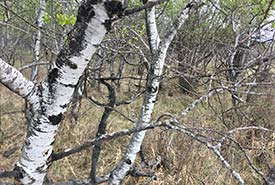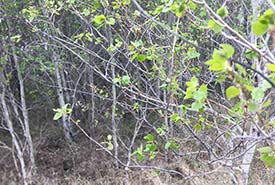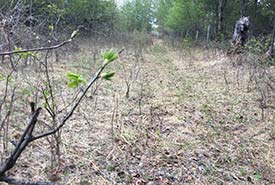The essential Asquith aspens

Trembling aspen at Asquith property, SK (Photo by NCC)
It’s difficult to imagine many natural habitats without the presence of trees. Trees provide humans and wildlife with essential needs; it’s easy to take them and forests for granted.
In their many shapes, sizes and varieties, trees can provide shade on a sunny day or give shelter from the wind, but their benefits go much deeper than simple human joys. Walking through the Nature Conservancy of Canada's (NCC's) Asquith property, 45 minutes west of Saskatoon, was my first time on an NCC property as a summer intern with the organization. Being in the communications and engagement departments, my first task was to find something on the trail to blog about. I quickly realized that dense pockets of trembling aspen populate much of the region. Curious as to how these trees earned their “trembling” name, a quick Google searched revealed that the flattened stem of their sprouted leaves causes the leaves to shake in even the gentlest of breezes.

Leaves of trembling aspen (Photo by NCC)
Trembling aspen’s unique white bark is difficult to miss along the trail, as its bright green leaves contrast with its branches. Birds make homes in many of these limbs, and, while out of sight, their chirping and fluttering noises dominate the peaceful environment. While not overly large in diameter, many of these trees have grown quite tall and provide shade along the trail.
What I didn’t realize is that dead trees, or snags, provide just as much use to an ecosystem as living ones. Many snags are present here, providing shelter to many species of wildlife. Woodpeckers hollow out cavities in snags, allowing opportunities for small animals to use the cavities for shelter from predators. The softened wood of snags gives new nesting opportunities for wildlife. Fallen trees also can be broken down by mosses and fungi, which allows the tree’s nutrients to be brought back into the soil. I found it interesting that trees prove to be useful to their environments, even after they have died.

NCC's Asquith trail gives hikers a taste of various habitats, including grasslands, sand dunes and forests. (Photo by NCC)
The Asquith trail routes through a variety of terrains, including grasslands, sand dunes and forests, giving hikers a small taste of some of the natural habitats that Saskatchewan has to offer. This was the first time I had been to Asquith, and I really enjoyed seeing the distinct landscapes that are so important to conservation efforts. I look forward to returning to Asquith later this summer to experience how the environment changes with the seasons, and hopefully learn more about the species that live here.


